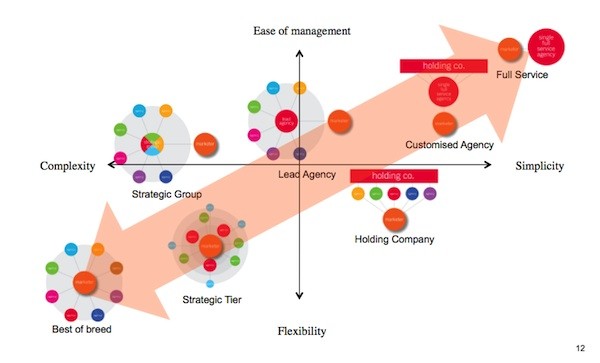The conversations from marketers over having too many agencies to manage, as reported from the “All That Matters” conference is not new, as the proposed solutions are not new. In fact, way back in 2010 we provided marketers with a comprehensive review of the main agency roster structures with an analysis of the strengths and weaknesses of each.
Consolidating the roster to a single lead agency or bundling up into a customised holding company solution is simply a reaction to a problem rather than a solution to the deeper problem facing modern marketing.
That problem is not the number of agencies on the roster, but the response of marketers to an ever increasing number of communication channels or consumer touch-points.
Too much to do?
Like a child in a candy shop, marketers are now faced with more channel choices than ever before and their reaction is usually to want to do everything. Marketing has been accused of suffering from the shiny new thing syndrome, where marketers are often attracted to the latest opportunity on the block to deliver that long desired competitive advantage.
Take Virtual and Augmented Reality as the latest examples.
Some marketers have justified this as wanting to take advantage of the first mover advantage, a high-risk strategy at the best of times. It is more likely it is driven by FOMO (Fear Of Missing Out) especially as many of the suppliers of the latest technology break-through will promote it as the new hot opportunity, eagerly supported by the content / news hungry media.
The issue here is just because something can be done, does not mean that it should be done. This is the cornerstone of great strategy. Strategy is not a plan of what needs to be done as much as a plan to let you decide what you will not do, so you can focus your limited resources on doing what is going to deliver the results.
As Sun Tzu famously said, “Strategy without tactics is the slowest route to victory. Tactics without strategy is the noise before defeat”.
The noise of many marketing departments complaining about the complexity of their roster and the volume of their work and the limitations of their resources is the noise of tactics without clearly defined strategy and therefore the noise before defeat.
Too little to do it with?
But the marketing budgets for many of these marketers remain the same. So while they are adding more channels to their marketing plan, requiring more specialist agencies to deliver to these channels, the amount invested into each channel is decreasing.
Too much marketing and advertising ends up being wallpaper that is easily ignored or forgotten, not because of poor strategy, but poor execution. With limited resources it is a smarter strategy to focus on executing fewer tactics well with the maximum opportunity for success than spreading your resources even thinner across multiple executions and dooming them all to failure.
But if you do go down the multiple channel approach you will naturally end up with multiple agencies scrambling for a bigger share of an increasingly fragmented marketing budget. Yet the marketers expect the agencies to work and collaborate together, when in actual fact they have been set up in fierce competition for a share of budget.
No wonder agencies are rapidly trying to diversify their capability offering in an attempt to secure a greater share of the marketing budget.
The marketer’s frustrations
In the meantime the marketer is increasingly frustrated on a number of levels:
- A constant frustration that they do not have enough marketing budget to deliver everything they have planned. I have yet to meet a marketer that does not want more money to spend.
- An increasing number of agencies on their roster so they find themselves devoting increased time to manage and co-ordinate these agencies. Time that would be better served actually marketing.
- Procurement has been very helpful reducing the cost paid to the agency, if only the savings were returned to marketing so it could be spent on one of the many new channels they are considering. But meanwhile the agency is looking for ways to cut their own costs to remain profitable, usually by getting increasingly more junior people working on the account.
Addressing the symptom not the problem
From this perspective, the complexity of the agency roster and the challenges of managing it are directly related to the strategy (or lack there of) developed by the marketers. Therefore any changes to the agency roster could simply be seen as changing deckchairs on the proverbial Titanic.
Consolidation to either a full service agency, or a Holding Company solution or perhaps the ‘P&G’ lead agency model is simply outsourcing the problem to a third party who has much to gain with the increased control and share of the marketing budget.
Also, all of these roster solutions usually require the marketer accepting a compromise on quality across the specialist capabilities they require, plus it can create a bottleneck, which will slow down response rates (not ideal for services based industries like telecommunications, travel and hospitality or financial services).
It is interesting that if this decision on agency rosters was really addressing the solution then we would not be witnessing the constant changing trends of consolidation and then diversification we see in the agency roster models over time. The ultimate solution would be both universal and sustainable.
The point is there is no one agency roster to suit all marketers requirements as the roster is a reflection of the marketing strategy and the requirement for the delivery of that strategy to the market place.
Solving the problem
So what is the solution? Well many in the C-suite are waking up to this challenge or issue and in response we have seen Zero Based Budgeting for marketing become a global trend out of the USA, especially for consumer goods businesses.
Many marketers struggle with ZBB as it requires a marketing budget to be built from nothing based on return on investment. Can you think of a faster way to bring focus to the infinite array of marketing activities you could undertake?
At the very heart of the agency roster debate is the role of the marketer. Some talked about the marketer being the integrator. There is also the Ring Master, the Conductor and any number of other metaphors.
But if marketers are finding their agency rosters are too complicated then the starting point is not to simply restructure them in a way that outsources the problem, but to review and align their roster to their specific strategic needs.
And if those strategic marketing needs are complicated and complex then, to paraphrase Albert Einstein, perhaps it is time for the marketer to look to achieve some marketing genius by “Taking the complex and making it simple”.
To achieve this you need to:
- Articulate a results-focused marketing strategy, rather then simply being a marketing service provider to the business.
- Identify and appoint the resources you need both internally and externally to deliver that strategy, no more and no less.
- Make a small allocation in the marketing budget to ‘test and learn’ new opportunities in a controlled and accountable way.
In this way you are able to make decisions on opportunities against the agreed strategy, knowing you have the resources at your disposal to deliver the implementation and more importantly the results and ensure you are not ‘missing out’ on new opportunities through a controlled assessment of those opportunities against the strategy.
Certainly a much more professional approach than simply changing your agency roster structure.
An abridged version of this post was published in Mumbrella Asia September 20, 2016
TrinityP3’s Strategic Supplier Alignment service helps you to untangle your supplier roster, understand its strengths and weaknesses, and develop an optimal structure to improve your performance.
Why do you need this service? Click here to learn more





